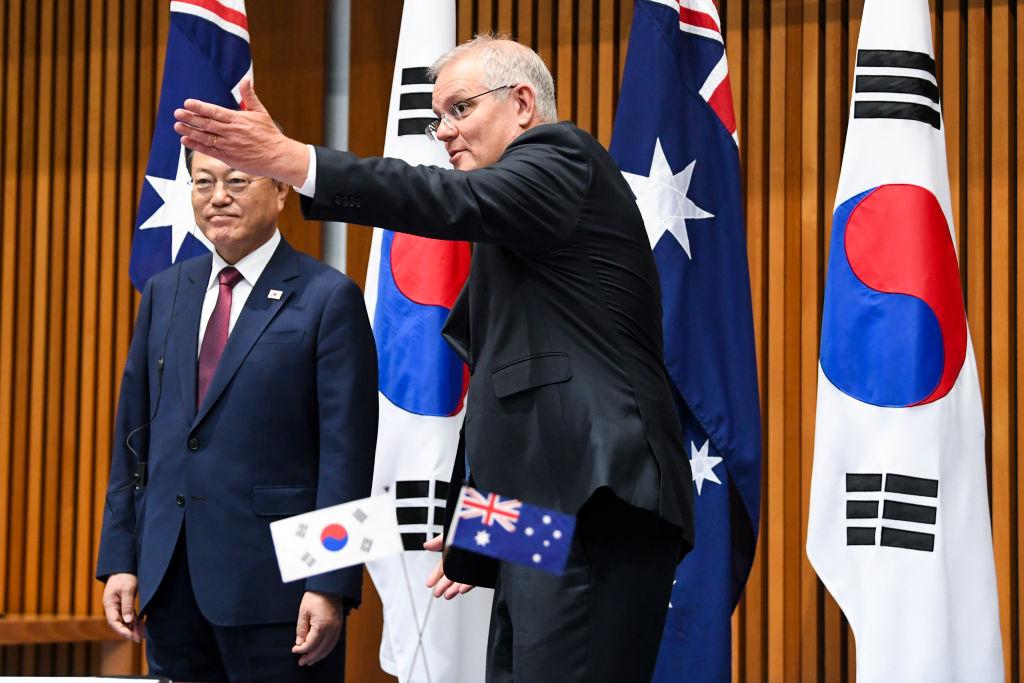
The US ‘hub and spoke’ bilateral alliance system is no longer fit for purpose and America, Australia and Japan are actively seeking to network security arrangements in the Indo-Pacific. A recognition of the advantage of networked security relationships can be seen in the growing number of these arrangements throughout the region: the Quad, AUKUS, the Japan–Australia Reciprocal Access Agreement, the Japan–India Acquisition and Cross-Servicing Agreement, and India’s invitation to Australia to join the Malabar naval exercise are all excellent examples. But, while South Korea is one of the most important US treaty allies in Asia, its modest approach to expanding defence ties has left it noticeably absent from many of these arrangements.
Outgoing President Moon Jae-in’s signature New Southern Policy seeks to diversify and strengthen the country’s diplomatic, economic and security relations. It includes a ‘peace pillar’ that prioritises broadening and strengthening South Korea’s security relationships with South and Southeast Asian countries. Yet this pillar is often criticised as the weakest and least fleshed-out element of the policy. South Korea – Southeast Asia security cooperation thus far has avoided ‘sensitive’ areas of hard security cooperation. The focus is on non-traditional security issues such as disaster response and maritime pollution, which, while important in their own rights, do little to directly contribute to South Korea’s national security.
Caught in a geopolitical tug-of-war between the US and China and heavily reliant on both, South Korea must weigh the consequences of more robust efforts to network security relationships in the region.
As president-elect Yoon Suk-yeol’s administration prepares to enter the Blue House on 10 May, his foreign policy team has articulated a more forward-leaning strategic direction based on ‘confident diplomacy and strong national security’. Throughout his campaign, Yoon stated his intentions to end Moon’s policies of ‘strategic ambiguity’ vis-à-vis US–China competition and scrap the ‘three nos’ by, among other things, purchasing additional THAAD air defence batteries from the US. That Yoon’s first five post-election phone calls were with the leaders of the Quad countries and the UK underscores the incoming administration’s intent to elevate South Korea’s regional leadership role through increased cooperation with like-minded democracies.
South Korea and Australia, as two militarily capable US allies with shared interests in maintaining stability in the Indo-Pacific and protecting the rules-based international order, should cooperate in pursuing a stronger defence relationship. Expanding security ties will enhance both countries’ security and contribute to deterrence in the Indo-Pacific as a whole.
As the new Yoon administration considers reformulating South Korea’s foreign policy, expanding security cooperation with Australia should be a high priority. Moon’s administration oversaw significant growth in the security relationship. Last year, Seoul and Canberra inked a $1 billion deal for 30 self-propelled howitzers and 15 armoured supply vehicles—Australia’s first major defence deal with an Asian country—and upgraded their relationship to a ‘comprehensive strategic partnership’.
While the administration was publicly adamant that these developments and Moon’s related visit to Australia were not pointed at China, the political signalling inherent in the timing of the deal was undeniably significant. The announcement came not long after Australia joined AUKUS, a development that antagonised China and deepened tensions in the China–Australia relationship. The visit was planned before the AUKUS announcement, yet it remains relevant that South Korea proceeded even in light of this potentially complicating strategic development.
Another promising sign of increasing defence ties, Hanwha Defense’s Redback infantry fighting vehicle is moving into the next phase of competition as one of two final candidates to become the Australian Army’s first dedicated IFV. After undergoing nine months of testing and evaluation by the Australian Defence Force, Hanwha is set to deliver the Redback to the Republic of Korea Army for two months of trials. These developments show that while South Korea remains dependent on China economically, it is placing greater trust in the US and its allies for its security, and is actively seeking to take on a greater regional role, even at the risk of angering China.
South Korea’s need for economic diversification away from China was the strongest motivation behind the New Southern Policy. South Korea and Australia share experiences of Chinese economic coercion and both governments are similarly elevating the importance of economic security. Alongside their defence deal, the two countries concluded an agreement for Australia to boost exports of rare earths to South Korea. China currently dominates the rare-earth industry, refining 80–90% of the world’s supply. South Korea is not alone in seeking to reduce its dependence on China for rare earths; the US and Japan are also striving to do the same. South Korea and Australia should build upon the rare-earths deal and pursue further cooperation in supply-chain resilience through their participation in the US’s proposed Indo-Pacific economic framework.
South Korean and Australian strategies are already moving in similar directions as both countries seek to reduce their economic reliance on China and broaden and deepen their security relationships with multiple partners. With Yoon’s expressed interest in attending the next Quad summit as an observer, the incoming administration would be well served to take the opportunity to strengthen the Australia – South Korea security relationship. During their phone call after the South Korean election, Prime Minister Scott Morrison expressed his interest to Yoon in visiting Seoul to further discussions on deepening cooperation. The Yoon team should build off the momentum of the forthcoming Quad leaders’ summit, set to take place in Japan in the next couple of months, and arrange for a South Korea – Australia summit to take place soon after.